How-to Safeguard Your Extreme Sports Trip
Are you ready to take on the adrenaline-pumping adventure of an extreme sports trip? Before you jump headfirst into the excitement, it's essential to ensure that you have all the necessary precautions in place to safeguard your experience.
From researching the destination to securing adequate insurance coverage, there are crucial steps you need to take to protect yourself and make the most of your extreme sports journey.
So, let's dive into the essential strategies that will help you navigate the exhilarating world of extreme sports with confidence and peace of mind.
Researching the Destination
Before embarking on your extreme sports trip, thoroughly research the destination to ensure you're aware of any potential risks and challenges.
Cultural immersion is an integral part of an extreme sports trip. Understanding the local customs, traditions, and social norms can significantly enhance your experience and interactions with the local community. Prior research on the destination's cultural practices will help you navigate through unfamiliar territories and engage more meaningfully with the local population.
Language barriers can often pose significant challenges when participating in extreme sports in foreign countries. Researching the primary language spoken at your destination and learning a few essential phrases can go a long way in facilitating communication and building rapport with the locals. It can also be beneficial to carry a pocket dictionary or utilize translation apps to bridge the language gap.
Moreover, consider reaching out to local guides or instructors who are fluent in both languages to ensure clear communication during your adventure activities.
Checking Equipment and Gear
After familiarizing yourself with the cultural aspects of your destination, now turn your attention to checking your equipment and gear to ensure they're in optimal condition for your extreme sports adventure.
Before embarking on your trip, it's crucial to conduct thorough gear maintenance and safety checks. Inspect all your gear, including helmets, harnesses, ropes, and protective padding, for any signs of wear and tear. Ensure that all fastenings and buckles are in good working condition, and replace any damaged gear. It's also essential to check the expiration dates on items like climbing ropes and carabiners, and replace them if necessary. Spending time on these checks can help prevent accidents and ensure a safer adventure.
In addition to gear maintenance, proper equipment sizing and fit are paramount for your safety during extreme sports. Ill-fitting gear can lead to discomfort, reduced performance, and increased injury risk. Check that your helmets snugly fit your head, and your harnesses are adjusted to the correct size. For activities like snowboarding or skiing, ensure that your boots and bindings are properly sized to your feet. This attention to detail will enhance your comfort and performance while minimizing the risk of injury.
Taking the time to ensure the proper fit of your equipment will contribute to a more enjoyable and safer extreme sports experience.
Assessing Personal Fitness Level

Assess your personal fitness level to determine your readiness for the physical demands of your extreme sports adventure. Understanding your physical limitations is crucial to ensuring your safety during the trip. Start by evaluating your current physical condition. Consider your stamina, strength, and flexibility, and how they align with the requirements of your chosen extreme sport. Assessing mental preparedness is equally important. Evaluate your ability to stay focused, manage stress, and make quick decisions in high-pressure situations. Engaging in extreme sports requires a strong and resilient mindset, so take the time to honestly assess your mental readiness.
To gauge your fitness level, consider engaging in activities that mimic the physical demands of your chosen extreme sport. For instance, if you plan to go mountain biking, assess your endurance and leg strength by taking long rides on varied terrains. If you're preparing for a rock climbing trip, practice upper body strength and grip endurance at a local climbing gym. By simulating the movements and intensity of your upcoming adventure, you can better understand where your current fitness level stands.
Moreover, consider seeking the guidance of a fitness professional to assess your overall physical readiness. They can help identify any areas that may need improvement and devise a tailored training plan to enhance your strength, endurance, and flexibility.
Understanding the Risks Involved
Evaluate the physical and mental preparedness you've gained from assessing your fitness level, as it will help you understand the risks involved in your chosen extreme sport.
Risk assessment is a critical step in ensuring your safety during extreme sports. Consider the specific dangers associated with your activity, such as the potential for falls, collisions, or environmental hazards. Understanding these risks allows you to prepare and take appropriate safety measures.
When assessing the risks, consider the factors that could impact your safety, such as weather conditions, terrain, and equipment reliability. For example, if you're planning a rock climbing trip, evaluate the stability of the rocks, the weather forecast, and the condition of your gear. By identifying potential hazards, you can take proactive measures to mitigate risks and enhance your safety.
Furthermore, understanding the mental and emotional demands of your chosen extreme sport is crucial. Activities like skydiving, big wave surfing, or base jumping require a high level of mental preparedness and emotional control. Assess your comfort level with these demands and consider whether you have the necessary psychological readiness to face the challenges involved.
In addition to risk assessment, familiarize yourself with the safety measures recommended for your specific extreme sport. This may include wearing appropriate protective gear, undergoing training, or following specific guidelines. By understanding the risks and adhering to safety measures, you can better safeguard your extreme sports trip and enjoy your adventure to the fullest.
Obtaining Proper Training and Certification

Consider obtaining proper training and certification before embarking on your extreme sports adventure to ensure you have the necessary skills and knowledge to stay safe and maximize your enjoyment. Participating in extreme sports requires adherence to specific safety protocols, which can be learned through instructional courses. These courses provide valuable insights into risk management, emergency procedures, and equipment handling, ultimately enhancing your overall preparedness for the challenges ahead.
Enrolling in accredited programs for your chosen extreme sport is crucial for skill development and safety awareness. These programs are designed to offer comprehensive training that covers essential aspects such as proper techniques, equipment usage, and understanding environmental factors. By undergoing such training, you can significantly reduce the likelihood of accidents or injuries during your extreme sports activities.
Furthermore, obtaining certification from reputable organizations not only validates your skills but also ensures that you're aware of industry best practices and safety standards. This recognition can provide you with peace of mind and may even be a requirement for participating in certain extreme sports events or competitions.
Developing a Communication Plan
Before you embark on your extreme sports adventure, ensuring effective communication is crucial for your safety and the success of your trip. Developing a communication plan can make a significant difference in handling emergencies, staying connected with your group, and overcoming language barriers. Here are some essential elements to consider when creating your communication plan:
- Emergency Contacts: Compile a list of emergency contacts, including local authorities, emergency services, and the nearest medical facilities. Share this information with your group and keep it easily accessible.
- Communication Devices: Choose reliable communication devices such as two-way radios, satellite phones, or GPS devices. Ensure that everyone knows how to operate them and that they're fully charged before setting out.
- Communication Protocols: Establish clear communication protocols within your group. Define emergency signals or codes and ensure that everyone understands their meaning and knows how to respond.
- Language Barriers: If you're traveling to a location where language barriers may be a concern, consider learning basic phrases in the local language or carrying translation tools to facilitate communication with locals.
- Regular Check-Ins: Set up regular check-in times with your group, especially when engaging in separate activities. This ensures that everyone is safe and accounted for throughout the trip.
Securing Adequate Insurance Coverage

To safeguard your extreme sports trip, securing comprehensive insurance coverage is essential for mitigating risks and ensuring financial protection in case of accidents or emergencies. When choosing the right policy, it's crucial to consider the specific activities you'll be participating in during your trip. Not all insurance policies cover extreme sports, so be sure to select one that specifically includes coverage for activities such as skydiving, rock climbing, or scuba diving.
Comparing quotes from different insurance providers is also important. Look for policies that offer adequate coverage for medical expenses, emergency evacuations, trip cancellations, and equipment protection. Consider the deductible and the maximum coverage limits to ensure they align with your needs. Additionally, check if the policy includes coverage for any pre-existing medical conditions and if there are any exclusions for certain activities or locations.
It's advisable to read the fine print of the insurance policy to understand the extent of coverage and any limitations. Some policies may have specific requirements for safety equipment usage or certifications for certain activities. Make sure to disclose all relevant information about your planned activities and any pre-existing conditions to the insurance provider to avoid potential issues with claims in the future.
Following Local Rules and Regulations
Make sure to familiarize yourself with and adhere to the local rules and regulations governing extreme sports activities in your destination. Understanding local regulations is crucial to ensure a safe and enjoyable experience while participating in extreme sports.
Here are some important considerations to keep in mind:
- Research: Before embarking on your extreme sports trip, take the time to research and understand the specific rules and regulations that apply to the activities you plan to engage in. Different locations may have varying laws and guidelines regarding extreme sports.
- Local Guidance: Seek guidance from local experts or authorities who are familiar with the area and its regulations. They can provide valuable insights and advice on how to navigate the local rules effectively.
- Cultural Awareness: Be mindful of the cultural context in which you'll be participating in extreme sports. Understanding and respecting the local customs and traditions can contribute to a harmonious and respectful experience.
- Environmental Impact: Consider the environmental impact of your extreme sports activities. Some destinations have strict regulations in place to protect natural habitats and wildlife, and it's essential to follow these guidelines.
- Safety Standards: Familiarize yourself with the safety standards and protocols that are enforced in your destination. Adhering to these guidelines can help prevent accidents and ensure a responsible approach to extreme sports.
Frequently Asked Questions
What Are Some Common Cultural Customs or Etiquette to Be Aware of When Participating in Extreme Sports in a Foreign Country?
When participating in extreme sports in a foreign country, it's crucial to be aware of cultural customs and etiquette. Respecting traditions and local interactions will enhance your experience and show cultural sensitivity during international travel.
Are There Any Specific Environmental Concerns or Conservation Efforts That Should Be Taken Into Consideration When Planning an Extreme Sports Trip?
When planning your extreme sports trip, it's important to consider the environmental impact of your activities. Look for conservation efforts in the area and be mindful of how your presence may affect the local ecosystem.
How Can I Ensure the Safety and Well-Being of Local Wildlife and Ecosystems While Engaging in Extreme Sports Activities?
To ensure the safety of local wildlife and ecosystems while engaging in extreme sports, always follow designated paths, avoid disturbing wildlife, and adhere to any conservation guidelines. Remember, wildlife protection and ecosystem preservation are crucial.
What Are Some Tips for Effectively Communicating With Local Emergency Services or First Responders in the Event of an Accident or Injury During an Extreme Sports Trip?
When you're in an extreme sports trip, it's crucial to have a plan for emergency communication in case of an accident. Be prepared for potential language barriers and cultural differences when interacting with local first responders.
Are There Any Unique Legal or Liability Considerations to Be Aware of When Participating in Extreme Sports in Different Countries or Regions?
When participating in extreme sports in different countries or regions, be aware of legal implications, liability risks, safety regulations, and insurance requirements. Understand emergency procedures, cultural awareness, and local customs to navigate effectively.
Conclusion
Before embarking on your extreme sports trip, take the time to thoroughly research your destination. Ensure your equipment is in top condition and evaluate your own fitness level. Understand the risks involved and obtain the necessary training and certification.
Develop a communication plan and secure proper insurance. Always follow local rules and regulations. By taking these precautions, you can enjoy your extreme sports trip with peace of mind and a focus on staying safe.
